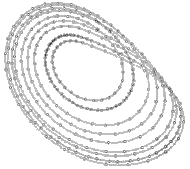 |
| Home | Research | Publications | Vita | Links | Contact |
Research Interests:
My current focus is on the analysis of time-series data from complex adaptive nonlinear systems. I use a variety of approaches, ranging from the traditional ones from nonlinear dynamics (delay reconstruction, Lyapunov exponents, etc.) to information theory and topological data analysis.In the past, I have done some work in the area of artificial intelligence: in particular, computer tools that autonomously analyze and/or design things. My focus has largely shifted away from this area. Please note!!! I do not currently work on AI -- including machine learning -- nor do I plan to in the future. Please do not contact me about projects in that area.
Current projects:
- Nonlinear time-series analysis: theory, algorithms, and applications!
- Computational topology: techniques for describing the morphology of an object, using only discrete data about that object, and applications of those algorithms to data analysis.
- Collective behavior in honeybee and bacteria colonies.
Some past projects:
- Information-theoretic analysis of ice-core data: the Shannon entropy rate of time-series data from ice cores reveals some pretty cool stuff about the paleoclimate.
- Solar-flare prediction: using computational topology and computational geometry to engineer features for forecasting methods.
- Human movement dynamics: this area has two distinct foci:
- understanding the nonlinear dynamics of movement (e.g., runners with amputations, which you can read about in this Physics Today piece or in this CHAOS paper, depending on how much technical detail you want).
- manipulating those dynamics: in particular, using machine learning and the dynamics of chaos to generate human motion sequences.
- Flow control: intentionally inducing, suppressing, and "guiding" chaotic flows in a fluid using micromachined flaps in the boundary layer of a jet.
- The nonlinear dynamics of computer performance: frameworks for modeling computers as deterministic nonlinear dynamical systems, and using those models to forecast their performance.
- Control of internet attacks using nonlinear dynamics, stochastic models, and control theory.
- Recurrence plots: a visualization tool that brings out correlations in time-series data.
- Phase-locked loop: using chaos to improve the capture range of a common and useful electronic circuit.
- CScience: an integrated software system that helps geoscientists construct age models (which relate depth to calendar age) for an ice or ocean-sediment core.
- Intelligent computation of reachability sets: automatically exploring the evolving geometry of the set of allowed paths of a spacecraft.
- PRET, a computer program that deduces the internal dynamics of a nonlinear black-box system solely from observations of its outputs, automating the process known to control theorists as system identification.
Many of the links in the "Current Projects" section above point to documents that describe current research opportunities. These range from one-semester undergraduate research projects through M.S. and Ph.D. theses to postdoctoral appointments. Please shoot me an email message if you're interested in any of these opportunities. And I'm happy to work with smart, independent students on projects of their own choosing, even if I don't know much about the associated area. As noted above, that does not extend to machine learning.